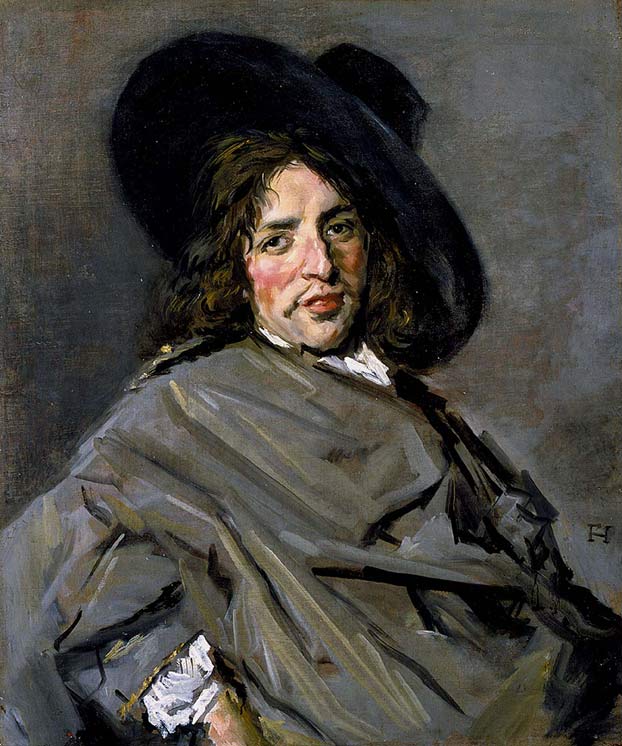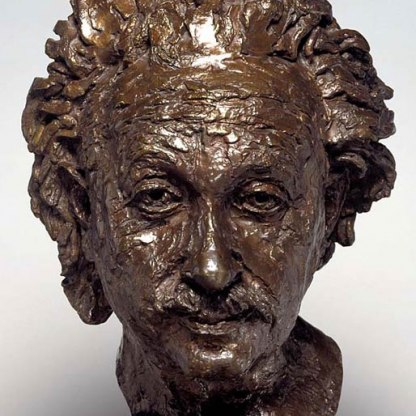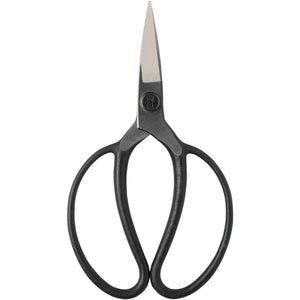Portrait of an Unknown Man

Few seventeenth-century Dutch portraits give so a vivid an impression of a living person as this brilliant late work by Frans Hals. Though the name of sitter has been lost, there is a sense of character here, of individuality, that no amount of polish or surface detail could enhance.
No attempt has been made to disguise the fact that this image consists of paint applied to canvas with a brush. Look at the swift, almost rough treatment of the man's cuff. Elsewhere the brushstrokes are just as thick and unrefined. By contrast, on the right-hand side of the cloak, dribbles suggest just how thin the paint was there and how quickly the artist applied it.
To our modern eyes certain details might suggest that we are looking into the eyes of a disreputable, slovenly character. The rakish angle of his hat, the cut of his moustache, the unkempt shoulder-length hair, the full red lips, the rather blotchy complexion: could this be one of the drunkards with whom historical anecdote tells us Frans Hals associated?
At some point before the painting was given to the Fitzwilliam in 1879, the background was painted brown and the sitter's great hat entirely overpainted, presumably in a misguided attempt to give him a more respectable air. Cleaning revealed it only in 1949.
In fact, far from being slovenly, this is a man at the height of contemporary fashion. A similar hat can be seen in a painting by Karel Dujardin in the Fitzwilliam, Italians with a Dog, below [362*], which dates from about the same time. In Hals' painting the man's grey cloak, which to us might seem rather drab, also probably proclaims his sharp, contemporary fashion sense.

The wearing of long hair had been a controversial statement in Holland earlier in the seventeenth century. In the 1640s, Protestant preachers, morally outraged at flowing male locks, quoted I Corinthians, 11, 14: 'doth not even nature itself teach you that, if a man wear his hair long, it is a shame unto him?' This dispute was settled in 1645, however, when church councils agreed that there were more important things to argue about.
But it is not only this man's fashion sense that suggests his modernity. He has allowed himself to be painted in an extraordinarily progressive style for the times. A comparison with a roughly contemporary, conventionally finished painting by Abraham Tempel in the Fitzwilliam, left [PD.14-1952], suggests just how bold Hals' treatment is.
Although he was admired in his day, particularly in his native Haarlem, it would be another two hundred years before Hals' late, rough style found champions among other painters and in other countries. Artists and theorists of the eighteenth century, like Sir Joshua Reynolds, were particularly critical of the artist's lack of 'finish,' and it was left to the nineteenth-century Impressionists, seeking a more spontaneous look, to rediscover him.
His fellow countryman, Vincent van Gogh, wrote two centuries after his death:
What a joy to see such a Frans Hals. How different from those pictures – there are so many of them – where everything has been carefully smoothed down in the same way.
The fluency and vigour with which Hals has applied the paint can be compared to the way the aged Titian painted certain passages of his Tarquin and Lucretia, left [914]. Like Titian, Hals worked until he was well into his eighties. The style here is not that of a drunkard or a short-sighted, arthritic old man, as was suggested in his own lifetime, but that of a creative artist who, even in extreme old age, did not give up the search for new and truthful modes of expression.
Themes and periods
Data from our collections database
(?) Coll. Rev. R.E. Kerrich
Acquisition and important dates
- Method of acquisition: Given
- Dates: 1879
Dating
Maker(s)
- Hals, Frans Painter
Materials used in production
Read more about this recordOther highlight objects you might like
Suggested Curating Cambridge products
Sign up to our emails
Be the first to hear about our news, exhibitions, events and more…





